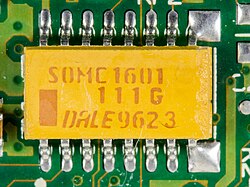What is Varistor?
Many electronic devices face serious problems when voltage suddenly becomes too high. These sudden increases are called voltage spikes or transients. These voltage spikes can damage or destroy delicate electronic circuits. One very common and effective way to stop this damage is by using a special component called a varistor. Varistors are often small, but they do a very important job. They protect the sensitive electronic parts inside our gadgets from getting ruined by overvoltage.
A Deeper Definition of Varistors
A varistor is a special type of electronic component. It is a resistor, but it does not have a fixed resistance value like a normal resistor. Its resistance changes in a very specific way. The resistance depends on the voltage applied across it. When the voltage is low or at its normal operating level, the varistor has a very high electrical resistance. This high resistance means it acts almost like an open circuit. So, very little current flows through it. And it does not affect the normal operation of the circuit. But when the voltage suddenly rises above a certain level, the varistor’s resistance dramatically drops. It becomes very low in an instant. This low resistance creates an easy path for the extra electrical current to flow through. This action diverts the harmful surge current away from the sensitive parts of the circuit. So the varistor protects the circuit. The name "varistor" itself tells us about its function. It comes from combining the words "variable" and "resistor." This name perfectly describes its behavior as a voltage-dependent resistor. This unique varistor characteristics and function makes it an essential transient voltage suppression component.

The primary purpose of a varistor is to protect circuits from high-voltage transients. These transients are very short but very powerful bursts of electrical energy. They can be caused by many things. Lightning strikes near power lines are a major cause. The switching of large electrical motors or other inductive loads can also create them. Even simple power grid adjustments by the utility company can send a surge down the line. Without protection, these spikes can instantly destroy microchips, transistors, and other components. That is why voltage protection is so important. Varistors provide this protection. They act very fast. And they can absorb large amounts of energy from these spikes. This keeps the voltage in the rest of the circuit at a safe level. So the circuit continues to work correctly and is not damaged. The varistor is a simple, cheap, and reliable solution to a very common and serious problem in electronics.
How Does a Varistor Work in a Circuit?
To truly understand what does a varistor do in a circuit, we must look at its internal structure and how it behaves electronically. A varistor is a semiconductor device. It is made from materials that have special electrical properties. The most common material used is zinc oxide (ZnO). The zinc oxide powder is mixed with small amounts of other metal oxides, like bismuth, cobalt, and manganese. This mixture is pressed into a disc or block shape at high pressure. Then it is heated at a very high temperature in a process called sintering. This process fuses the particles together and creates a ceramic body. During this process, a complex microstructure of zinc oxide grains is formed. Each grain is surrounded by a thin boundary layer of the other metal oxides. These grain boundaries are the key to how does a varistor work.
Each of these grain boundaries acts like a tiny semiconductor junction. At normal operating voltages, these junctions have a very high resistance. So they block the flow of current. The varistor as a whole is made of millions of these grains in series and in parallel. So the total resistance of the device is extremely high. The varistor is connected in parallel with the circuit it needs to protect. This means it is connected between the power line and the ground line. Because its resistance is so high during normal operation, almost no current flows through it. And the varistor is essentially invisible to the rest of the circuit. The circuit gets the power it needs and works as designed.
The situation changes completely when a voltage spike occurs. When the voltage across the varistor rises above its specific "clamping" voltage, the semiconductor junctions at the grain boundaries begin to break down. This is a controlled breakdown, not a destructive one. The high voltage gives the electrons enough energy to cross the boundaries. So a large current starts to flow through the varistor. The resistance of the varistor drops to a very low value in just a few nanoseconds. This extremely fast response is critical for protection. The low-resistance path diverts the huge surge of current safely from the power line directly to the ground. This process absorbs the energy of the spike. And it "clamps" the voltage across the protected circuit to a safe level. The sensitive components in the main circuit never see the dangerously high voltage.
After the voltage spike is over and the line voltage returns to normal, the varistor automatically resets itself. The semiconductor junctions stop conducting. And its resistance goes back to being very high. The varistor is now ready to protect against the next surge. This ability to handle many surge events makes it a very useful and reusable protection device. It is a simple but very powerful gatekeeper for electrical voltage.
Understanding the Different Types of Varistors Explained
While the basic principle is the same, varistors come in different forms. The most common type is the Metal Oxide Varistor (MOV). This is the type we have been discussing, made primarily from zinc oxide. MOVs are the most popular choice for general-purpose surge protection. Their popularity comes from several key advantages. They are very effective. They can handle very large surge currents and absorb a lot of energy. They react extremely quickly to voltage spikes. And they are very inexpensive to manufacture. This makes them perfect for a wide range of varistor applications for surge protection. You can find them in power strips, surge protectors, power supplies for computers, and inside appliances like TVs and washing machines. Their job is to protect these devices from power line disturbances.
MOVs have many good characteristics. Their fast response time, often less than 25 nanoseconds, is crucial for protecting modern electronics. They can handle peak currents that can be thousands of amperes. And they are available in a wide range of voltage and energy ratings. This means engineers can choose the perfect MOV for almost any application. Their small size is another benefit. So they can be easily fitted onto crowded printed circuit boards (PCBs). But MOVs do have a limitation. They degrade over time. Each surge they absorb causes a small, permanent change in their internal structure. After many surges, their clamping voltage can decrease. Eventually, they can fail. A failed MOV might no longer provide protection, or it could fail as a short circuit, which can be a safety hazard. For this reason, MOVs are often used together with a fuse or a thermal cutout device.
Another type of varistor is the Silicon Carbide (SiC) varistor. This was an older technology that came before the MOV. Silicon carbide varistors are made from grains of silicon carbide. They work in a similar way to MOVs. But they have some disadvantages. They draw a significant amount of standby current during normal operation. This means they waste power. Their clamping voltage is also less stable compared to an MOV. For these reasons, MOVs have replaced SiC varistors in most low and medium-power applications. But Silicon Carbide varistors are still used in some high-power and high-voltage systems because they are very robust and can handle extreme conditions. The choice between different types of varistors explained by the needs of the specific circuit. For most consumer and commercial electronics, the Metal Oxide Varistor (MOV) is the best choice.
Varistor Symbols and Key Characteristics
In electronic diagrams, called schematics, special symbols are used to represent each component. The standard varistor symbol in electronics helps engineers and technicians understand the circuit's design. The symbol looks like a standard resistor symbol, which is a zigzag line. But it has a diagonal line drawn through it. This diagonal line indicates that its resistance is variable. Sometimes, the letter 'V' or 'Z' is written next to the symbol. This notation clearly identifies it as a voltage-dependent component.
The symbol for a Metal Oxide Varistor (MOV) is often the same standard varistor symbol. Sometimes, the letters "MOV" are written next to it to be more specific. These symbols are essential for reading circuit diagrams. They show exactly where the varistor is placed in the circuit. This is almost always in parallel with the components it is protecting, connecting the line that needs protection to a stable reference point, like ground. This placement ensures that when the varistor activates, it creates a direct path for the surge current to bypass the sensitive circuitry. An engineer looking at a schematic can immediately see the protection strategy used in the design because of this clear symbol.
Beyond its symbol, several key varistor characteristics and function parameters define its performance. The most important is the Varistor Voltage or Nominal Voltage. This is the voltage across the varistor when a small, specific test current (usually 1 milliampere) is passed through it. It indicates the voltage level at which the varistor begins to conduct significantly. Another critical parameter is the Clamping Voltage. This is the maximum voltage that will appear across the varistor when it is subjected to a specific high-current surge. This value tells you the maximum voltage the protected circuit will ever see. A lower clamping voltage means better protection.
The Energy Absorption rating is also very important. It is measured in Joules (J). This rating specifies the maximum amount of energy the varistor can absorb from a single surge without being damaged. A higher joule rating means the varistor can handle more powerful surges. The Peak Current rating indicates the maximum surge current, measured in amperes (A), that the varistor can withstand for a very short time. Finally, the Response Time is the time it takes for the varistor to switch from its high-resistance state to its low-resistance state when a surge occurs. This is typically measured in nanoseconds (ns). A faster response time is better because it clamps the voltage spike more quickly. Engineers must carefully consider all these parameters to select the right varistor for their specific application.
Widespread Varistor Applications for Surge Protection
Varistors are one of the most common components used for voltage protection in electronics. Their applications are incredibly broad because the threat of voltage transients is present in almost all electrical systems. One of the most well-known varistor applications for surge protection is in Surge Protection Devices (SPDs). These are the power strips and wall adapters that we use to protect our expensive electronics like computers, televisions, and home theater systems. Inside every one of these devices, you will find one or more MOVs. They are connected between the hot, neutral, and ground wires of the AC power line. When a voltage surge from the power grid occurs, the MOVs immediately conduct the excess energy safely to the ground wire. So the surge never reaches the connected equipment.
Varistors are also essential as a transient voltage suppression component inside the power supplies of countless electronic devices. The power supply unit (PSU) in a desktop computer, the power adapter for a laptop, and the internal power circuits in a modern television all contain varistors. They provide a first line of defense against any transients coming from the wall outlet. This protection is vital for the long-term reliability of these products. Without this internal protection, the devices would be much more likely to fail during a thunderstorm or a power grid fluctuation.
The use of varistors extends far beyond consumer electronics. They are critical in industrial settings. Factory floors have large motors, welders, and other heavy machinery that are constantly being switched on and off. This switching creates powerful electrical transients that can disrupt or damage sensitive control systems, like programmable logic controllers (PLCs). Varistors are installed in these control cabinets to suppress these transients and ensure the reliable operation of the manufacturing equipment.
Furthermore, the telecommunications industry relies heavily on varistors. Telephone lines and network cables can be very long. So they can pick up voltage surges induced by nearby lightning strikes. Varistors are used in the line interface cards of communication equipment to protect them from such events. The automotive industry also uses varistors to protect the ever-increasing amount of sensitive electronics in modern vehicles from voltage transients generated by the alternator, ignition system, and various motors. In summary, wherever there is a sensitive electronic circuit connected to a power source or a long communication line, there is a very good chance that a varistor is quietly standing guard, ready to protect it.









